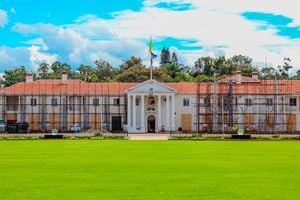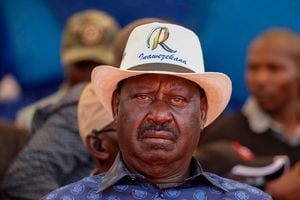My Azimio manifesto takeaway

Azimio presidential candidate Raila Odinga speaking at Nyayo Stadium in Nairobi on June 6, 2022 during his manifesto launch.
I’ve just gone through the manifesto put out by the Azimio la Umoja One Kenya Coalition Party and here is my take. But before I pronounce judgement, allow me to briefly spell out what I expect to see in an economic manifesto of a major political party in Kenya today.
First, I want to see a programme teeming with ambition—a blueprint to turbocharge the economy and to snap it out of stagnation. Secondly, I expect to see bold and new economic thinking.
For me, manifestos should not be just a matter of listing down lofty promises. You must demonstrate to me that you have a good grasp of where the economy is, where it is likely to go, and what must be done to mitigate the economic challenges.
Secondly, I want those vying for the presidency to give me a new list of large-scale transformative projects they plan to implement, including a clear time frame of when we can expect their delivery.
Enough of theory. Here are the things that stand out for me in the Azimio manifesto. First, the Sh6,000 monthly cash transfer programme. Can this proposal pass the test of fiscal sustainability? Where is the money to come from in a context of diminishing revenues, a bloated public wage bill and burgeoning debt service obligations—a large proportion of which is denominated in foreign currencies?
Does this proposal amount to a policy of development through handouts?
Inequality
If you look closely at the way the problem of inequality has become entrenched in our society and you come to terms with the exponential rate at which the number of citizens living below the poverty line has grown, you will accept that the vision and thinking around Azimio’s proposal of the stipend for the vulnerable and socially excluded makes sound economic sense.
History will record that the biggest mistake we have made in our nearly 60 years as a republic was to equate development with brick and mortar. We have had quantitative growth without qualitative development. While the standard of living of a small segment of society has been growing, the standard of life of the majority has fallen badly.
Indeed, the proposal for an expanded cash transfer programme is not without parallels in the rest of the World where many countries are experimenting with what is known as the 4U’s: Universal basic income, universal health coverage, universal capital grants and universal pensions.
Key plank
A programme in the image of the Azimio pledge is a key plank in the manifesto of India’s Congress Party, where it pledged 6,000 rupees monthly to the bottom 20 per cent of the population. Under the so-called Inua Jamii, the administration of President Kenyatta disbursed a whopping Sh 8.7 billion in cash transfers to 1,094, 372 households in January 2020.
The second thing in the Azimio manifesto that makes sense to me is the promise to deal with the cost of living crisis. Prices are rising—and going up across a broad spectrum of goods and services and adversely impacting especially low-income households.
The shilling is under intense pressure and the prognosis is that we are slowly drifting towards dollar shortages. Indeed, the biggest risk to low and stable consumer prices in the medium term is the war in Ukraine.
Azimio’s proposal is a promise to introduce tax relief packages and incentives to cushion households from unpredictable increase in prices of unga, fuel, energy and mobile data. I wanted more. I wanted a commitment to deal with entrenched corruption in the energy sector parastatals and a pledge to conclude ongoing negotiations with independent power producers.
I also wanted to hear about commitment to consummate and close the Dar es salaam-Mombasa natural gas pipeline deal because I believe that the conversion of diesel generators to natural gas is going be the game changer in our efforts to deliver cheap power to our people.
The manifesto also highlighted public debt as a big issue. But beyond promising to restructure and renegotiate debt, the proposals are light and short on long-term and sustainable solutions. We must have a national conversation around institutional solutions to our growing indebtedness. We need to debate introduction of an independent National Treasury Management Agency to take over the fiscal agency role from the Central Bank of Kenya.
Domestic debt
On the domestic debt front, I had expected to hear about deep reforms in the market for government securities. The idea of establishing a system of primary dealers has been with us since 2013. How about a moratorium on corruptly procured and expensive commercial debts?
I was going through the external debt register the other day and this is what I saw: We have in our books a debt of USD67 million (Sh71 billion) in respect of both Kimwarer and Arror dams, which we will be servicing until November 2035. Who stole the billions?





